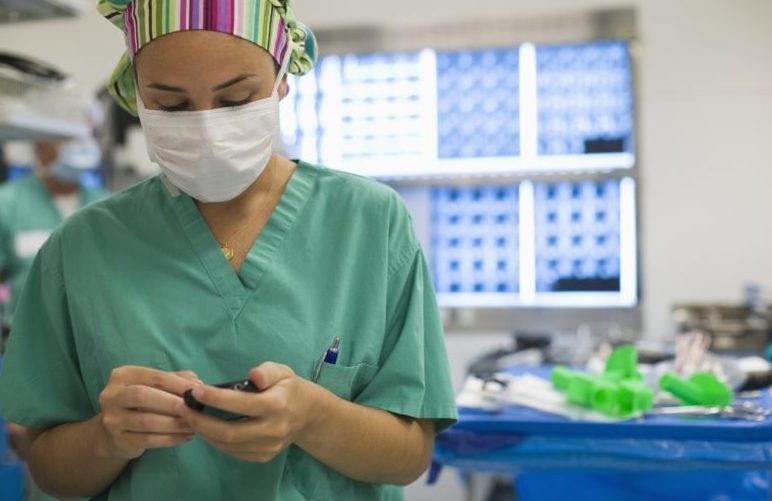The importance of mobile device disinfection in the healthcare setting

A healthcare professional’s “third hand” can carry and spread pathogens
By Medline Newsroom Staff | October 12, 2021
Nearly 90% of healthcare professionals regularly use a mobile device for work-related tasks, including accessing medical records, checking lab results and/or communicating with colleagues and patients.
“Hand held devices are carried everywhere — in and out of patient rooms and throughout healthcare facilities — and for this reason, they have been referred to as our third hand. And like our other two hands, they can become contaminated,” said Sue Barnes, RN, independent clinical consultant, infection prevention and control, during the recent Medline webinar: “Surface Disinfection Utilizing UV Light.”
Numerous studies have linked the use of hand-held devices in healthcare settings with the spread of pathogens. A 2019 study found harmful bacteria, including drug-resistant pathogens, on 94% of healthcare professionals’ cell phones, placing staff and patients at risk of contamination.
The use of mobile technology in healthcare practice is increasing “at a much faster pace than cleaning protocols have been developed and widely implemented,” said Barnes, with patient- and visitor- contaminated devices also contributing to the risk of pathogen transmission. While there are no established guidelines regarding the frequency and process for disinfecting mobile devices, “I think we would agree that there is ample evidence to support regular cleaning of all of these devices in healthcare – whether the property of a healthcare provider, a patient or a visitor.”
Germicidal wipes vs. UV-C disinfection
The use of germicidal wipes is the most common method of disinfecting cell phones and tablets; however, the practice has “limitations,” said Barnes. The effectiveness of wipes is affected by “human factors,” including the length of time that the device is wiped, variability of contact time, dry time and diligence. The disinfectant in certain wipes can also damage the electronic devices, and disposal of the wipes, along with the gloves generally required for use, contribute to landfill waste.
A UV-C device utilizes ultraviolent energy to kill bacteria and other pathogens. This method offers an “expedient, chemical free, hands free, automated, reliable and repeatedly effective” alternative to germicidal wipes for disinfecting cell phones and tablets, said Barnes.
Assessment of risk
In deciding which method to use, Barnes suggested that hospitals should conduct a risk assessment related to individual departments and patient populations. In areas where patients are at greater risk of infection, UV-C technology may be a safer, more effective process.
In addition, in the absence of a dedicated mobile device cleaning protocol, Barnes recommended expanding hospital hand hygiene protocols to include cell phones and tablets.
To help facilities mitigate the risk of pathogen transmission via mobile devices, Medline partnered with PhoneSoap earlier this year, and is now the exclusive distributor of ExpressPro*, a rapid disinfection station for tablets and cell phones. Lab testing has shown that ExpressPro’s 30-second disinfection cycle eliminates up to 99.99% of pathogens from devices, including C. difficile, MRSA, Coronavirus-229E and SARS CoV-2.
Learn more about how Medline helps fight the spread of infection.
* Not intended for use on medical devices.
Medline Newsroom Staff
Medline Newsroom Staff
Medline's newsroom staff researches and reports on the latest news and trends in healthcare.
